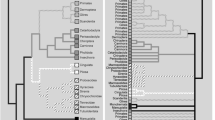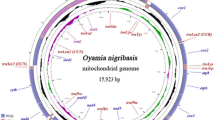Abstract
Part of the 12S rDNA gene was amplified and sequenced for 11 placental mammals, 3 marsupials, and 2 monotremes. Multiple alignments for these sequences and nine additional placental sequences taken from GenBank were obtained using CLUSTAL. Phylogenetic analyses were performed using standard parsimony, transversion parsimony, and Lake's method of invariants. All of our analyses uniteLoxodontia withDugong. Procavia, in turn, is a sister group to these taxa, thus supporting the monophyly of the Paenungulata. Perissodactyls are a sister group to paenungulates when transitions and transversions are both included but not when transitions are omitted. Likewise, cetaceans are a sister group to artiodactyls on minimum length trees under standard parsimony but not under transversion parsimony. Rodent monophyly and bat monophyly also receive mixed support, as does a putative alliance between primates and lagomorphs. Interestingly, the percentage divergence between the echidna and the platypus is less than for the rat and mouse.
Similar content being viewed by others
Literature cited
Adkins, R. M., and Honeycutt, R. L. (1991). Molecular phylogeny of the superorder Archonta.Proc. Natl. Acad. Sci. USA 88 10317–10321.
Allard, M. W., Miyamoto, M. M., and Honeycutt, R. L. (1991). Tests for rodent polyphyly.Nature 353 610–611.
Ammerman, L. K., and Hillis, D. M. (1992). A molecular test of bat relationships: Monophyly or diphyly?Syst. Biol. 41 222–232.
Archer, M., Flannery, T. F., Ritchie, A., and Molnar, R. E. (1985). First Mesozoic mammal from Australia—an early Cretaceous monotreme.Nature 318 363–366.
Bailey, W. J., Slightom, J. L., and Goodman, M. (1992). Rejection of the “flying primate” hypothesis by phylogenetic evidence from the epsilon-globin gene.Science 256 86–89.
Baker, R. J., Novacek, M. J., and Simmons, N. B. (1991). On the monophyly of bats.Syst. Zool. 40 216–231.
Felsenstein, J. (1978). Cases in which parsimony and compatibility methods will be positively misleading.Syst. Zool. 27 401–410.
Felsenstein, J. (1983). Inferring evolutionary trees from DNA sequences. In Weir, B. S. (ed.),Statistical Analysis of DNA Sequence Data, Dekker, New York, pp. 133–150.
Fischer, M. (1989). Hyracoids, the sister-group of perissodactyls. In Prothero, D., and Schock, R. M. (eds.),The Evolution of Perissodactyls, Oxford University Press, New York, pp. 37–56.
Gingerich, P. D., Smith, D. H., and Simons, E. L. (1990). Hind limbs of EoceneBasilosaurus: Evidence of feet in whales.Science 249 154–157.
Goodman, M., Czelusniak, J., and Beeber, J. E. (1985). Phylogeny of primates and other eutherian orders: A cladistic analysis using amino acid and nucleotide sequence data.Cladistics 1 171–185.
Graur, D., Hide, W. A., and Li, W.-H. (1991). Is the guinea-pig a rodent?Nature 351 649–651.
Hamilton, W. R. (1973). The Lower Miocene ruminants of Gebel Zelten, Libya.Bull. Br. Mus. (Nat. Hist.) Geol. 21 75–150.
Irwin, D. M., Kocher, T. D., and Wilson, A. C. (1991). Evolution of the cytochrome b gene of mammals.J. Mol. Evol. 32 128–144.
Kleinschmidt, T., Czelusniak, J., Goodman, M., and Braunitzer, G. (1986). Paenungulata: a comparison of the hemoglobin sequences from elephant, hyrax, and manatee.Mol. Biol. Evol. 3 427–435.
Kocher, T. D., Thomas, W. K., Meyer, A., Edwards, S. V., Paabo, S., Villablanca, F. X., and Wilson, A. C. (1989). Dynamics of mitochondrial DNA evolution in animals: Amplification and DNA sequencing with conserved primers.Proc. Natl. Acad. Sci. USA 86 6196–6200.
Kraus, F., and Miyamoto, M. M. (1991). Rapid cladogenesis among the pecoran ruminants: evidence from mitochondrial DNA sequences.Syst. Zool. 40 117–130.
Lake, J. A. (1987). Rate-independent technique for analysis of nucleic acid sequences: Evolutionary parsimony.Mol. Biol. Evol. 4 167–191.
Li, W.-H., and Gouy, M. (1991). Statistical methods for testing molecular phylogenies. In Miyamoto, M. M., and Cracraft, J. (eds.),Phylogenetic Analysis of DNA Sequences, Oxford University Press, New York, pp. 249–277.
Li, W.-H., Hide, W. A., Zharkikh, A., Ma, D.-P., and Graur, D. (1992). The molecular taxonomy and evolution of the guinea pig.J. Hered. 83 174–181.
Luckett, W. P., and Hartenberger, J.-L. (1993). Monophyly or polyphyly of the order Rodentia: Possible conflict between morphological and molecular interpretations.J. Mamm. Evol. 1 127–147.
Mindell, D. P., Dick, C. W., and Baker, R. J. (1991). Phylogenetic relationships among megabats, microbats, and primates.Proc. Natl. Acad. Sci. USA 88 10322–10326.
Miyamoto, M., and Goodman, M. (1986). Biomolecular systematics of eutherian mammals. Phylogenetic patterns and classification.Syst. Zool. 35 230–240.
Novacek, M. J. (1992a). Mammalian phylogeny: shaking the tree.Nature 356 121–125.
Novacek, M. J. (1992b). Fossils, topologies, missing data, and the higher level phylogeny of eutherian mammals.Syst. Biol. 41 58–73.
Novacek, M. J., and Wyss, A. (1986). Higher-level relationships of the Recent eutherian orders: Morphological evidence.Cladistics 2 257–387.
Pascual, R., Archer, M., Jaureguizar, E. O., Prado, J. L., Godthelp, H., and Hand, S. J. (1992). First discovery of monotremes in South America.Nature 356 704–706.
Pettigrew, J. D. (1986). Flying primates? Megabats have the advanced pathway from eye to midbrain.Science 231 1304–1306.
Prothero, D., and Schoch, R. M. (1989). Origin and evolution of the Perissodactyla: Summary and synthesis. In Prothero, D., and Schoch, R. M. (eds.),The Evolution of Perissodactyls, Oxford University Press, New York, pp. 504–529.
Prothero, D. R., Manning, E. M., and Fischer, M. (1988). The phylogeny of the ungulates. In Benton, M. J. (ed.),The Phylogeny and Classification of the Tetrapods, Vol. 2. Mammals, Clarendon Press, Oxford, pp. 201–234.
Rasmussen, D. T., Gagnon, M., and Simons, E. L. (1990). Taxeopody in the carpus and tarsus of Oligocene Pliohyracidae (Mammalia: Hyracoidea) and the phyletic position of hyraxes.Proc. Natl. Acad. Sci. USA 87 4688–4691.
Saiki, R. K., Gelfand, D. H., Stoffel, S., Scharf, S. J., Higuchi, R., Horn, G. T., Mullis, K. B., and Erlich, H. A. (1988). Primer-directed enzymatic amplification of DNA with a thermostable DNA polymerase.Science 239 487–491.
Sanger, F., Nicklen, S., and Coulson, A. R. (1977). DNA sequencing with chain-terminating inhibitors.Proc. Natl. Acad. Sci. USA 74 5463–5467.
Shoshani, J. (1986). Mammalian phylogeny: Comparison of morphological and molecular results.Mol. Biol. Evol. 3 230–240.
Simmons, N. B., Novacek, M. J., and Baker, R. J. (1991). Approaches, methods, and the future of the chiropteran monophyly controversy: A reply to J. D. Pettigrew.Syst. Zool. 40 239–243.
Simpson, G. G. (1945). The principles of classification and a classification of mammals.Bull. Am. Mus. Nat. Hist. 85 1–350.
Swofford, D. L. (1991). PAUP: Phylogenetic Analysis Using Parsimony, Version 3.0s. Computer program distributed by the Illinois Natural History Survery, Champaign, IL.
Swofford, D. L., and Olsen, G. J. (1990). Phylogeny reconstruction. In Hillis, D. M., and Moritz, C. (eds.),Molecular Systematics, Sinauer Associates, Sunderland, MA, pp. 411–501.
Thewissen, J. G. M., and Domning, D. P. (1992). The role of phenacodontids in the origin of the modern orders of ungulate mammals.J. Vert. Paleo. 12 494–504.
Westerman, M., and Edwards, D. (1991). The divergence between echidna (Monotremata: Tachyglossidae) and platypus (Monotremata: Ornithorhynchidae)—new data from DNA studies.Austral. Mammal. 14 115–120.
Wible, J. R., and Novacek, M. J. (1988). Cranial evidence for the monophyletic origin of bats.Am. Mus. Novit. 2911 1–19.
Ye, J. (1989). Middle Miocene artiodactyls from the northern Junggar Basin.Vertebr. Palasiat. 27 50–52.
Author information
Authors and Affiliations
Rights and permissions
About this article
Cite this article
Springer, M.S., Kirsch, J.A.W. A molecular perspective on the phylogeny of placental mammals based on mitochondrial 12S rDNA sequences, with special reference to the problem of the Paenungulata. J Mammal Evol 1, 149–166 (1993). https://doi.org/10.1007/BF01041592
Issue Date:
DOI: https://doi.org/10.1007/BF01041592




